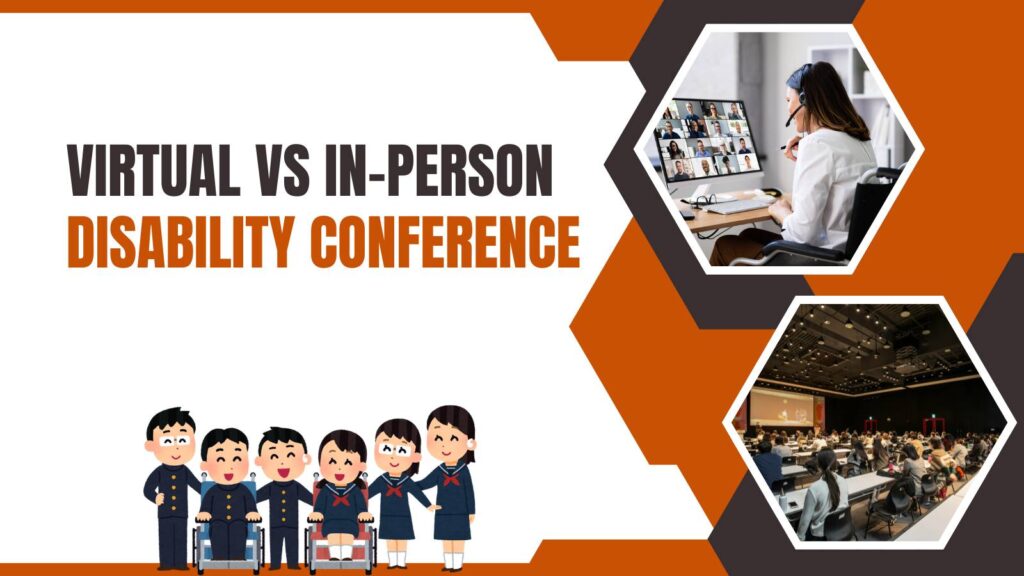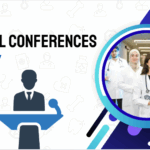Attending a disability conference has become a cornerstone for professionals seeking to enhance their knowledge, expand their network, and stay at the forefront of innovations in accessibility, assistive technology, and inclusive practices. These conferences serve as hubs for advocacy, professional growth, and sharing insights across industries dedicated to disability support and inclusion.
Rise of virtual conferencing technology has changed the landscape, presenting professionals with a critical choice: attend online or experience the benefits of an in-person conference? Both formats have unique advantages and limitations that impact learning, engagement, and professional opportunities. Understanding these differences is essential for making an informed decision that aligns with personal and professional goals.
This article dives deep into the benefits, drawbacks, and practical considerations of both virtual and in-person disability conferences, helping professionals determine what’s best for their growth and accessibility needs.
Why Choosing the Right Conference Format Matters
Professional disability conferences are more than just events—they are opportunities to immerse oneself in industry knowledge, connect with like-minded professionals, and engage with thought leaders. Attendees gain exposure to the latest research, innovative assistive technologies, policy updates, and best practices for inclusion.
The choice of conference format can significantly affect the overall experience. While a virtual conference may be convenient, it may lack the networking and hands-on learning opportunities that in-person events provide. Conversely, in-person conferences offer richer engagement but may be logistically challenging and expensive. By carefully evaluating the pros and cons of each, professionals can optimize their conference experience, ensuring meaningful participation, knowledge retention, and career advancement.
Virtual Disability Conferences: Benefits and Limitations
Flexibility and Convenience
Virtual disability conferences allow attendees to join sessions from any location, whether home, office, or even while traveling. This flexibility is especially beneficial for professionals with mobility challenges, caregiving responsibilities, or tight work schedules. Many virtual conferences provide on-demand access to recorded sessions, enabling participants to learn at their own pace and revisit important presentations.
For example, a professional attending a virtual conference on assistive technology could watch live demos and immediately implement the insights into their workplace without taking time off or arranging travel. This level of convenience also makes it easier to attend multiple conferences in a year, expanding exposure to knowledge and trends across regions and industries.
Accessibility Advantages
Virtual platforms often include a suite of accessibility features designed to support diverse needs. Features such as live captions, screen reader compatibility, adjustable text sizes, sign language interpretation, and real-time translation make virtual conferences highly inclusive. Professionals with visual or hearing impairments can fully participate without facing the physical barriers that may exist in traditional venues.
Moreover, virtual conferences allow attendees to customize their experience. They can adjust video quality to save bandwidth, control sound levels, or choose breakout rooms that focus on topics relevant to their professional interests. For international professionals, this ensures equitable access to content that may otherwise be geographically restricted.
Cost-Effectiveness
One of the most compelling reasons to attend virtual conferences is cost savings. Traditional in-person conferences often involve expenses such as airfare, accommodation, meals, transportation, and event registration. Virtual conferences reduce or eliminate most of these costs, making professional development more accessible to organizations and individuals alike.
For nonprofit organizations or small teams, virtual conferences allow multiple participants to gain access without the financial strain associated with travel. This democratization of access ensures that professionals from diverse backgrounds can participate and benefit equally.
Engagement Challenges
Despite their advantages, virtual conferences face challenges related to engagement and interaction. Online participants may struggle to remain focused due to distractions from emails, notifications, or home responsibilities. Additionally, networking is less spontaneous; meaningful conversations and chance encounters that often happen in hallways, breakout sessions, or during social events are harder to replicate online.
Some professionals find virtual formats less motivating for active participation, and without structured networking tools or facilitator support, interactions may feel forced or superficial. It requires proactive effort to engage with speakers, join discussion groups, or participate in virtual meetups to maximize value.
In-Person Disability Conferences: Benefits and Limitations
Face-to-Face Networking Opportunities
In-person disability conferences are unparalleled for networking. Professionals can meet peers, industry leaders, mentors, and potential collaborators in meaningful ways that foster long-term relationships. Casual interactions during coffee breaks, lunches, or social events often lead to collaborations, partnerships, or career opportunities.
Networking in person allows for non-verbal cues, body language, and spontaneous discussions that virtual platforms cannot fully replicate. Attendees can build trust, exchange business cards, and engage in conversations that may lead to mentoring or collaborative research initiatives.
Hands-On Learning Experiences
In-person conferences provide opportunities for interactive learning that are difficult to replicate online. Workshops, demonstrations, and training sessions allow participants to engage directly with assistive technology, adaptive equipment, or innovative accessibility solutions.
For instance, professionals attending a hands-on session on mobility aids can test devices, ask questions to product specialists, and understand real-world applications. This tactile engagement ensures deeper understanding and practical knowledge that can be immediately applied in workplaces, clinics, or educational settings.
Enhanced Focus and Immersion
Attending a conference physically allows for immersive engagement. Being away from home or office distractions helps participants focus entirely on the content, discussions, and workshops. Immersion encourages active learning, better retention, and higher engagement during panel discussions, Q&A sessions, and collaborative exercises.
This environment also facilitates a sense of community, as professionals share experiences, challenges, and solutions in real-time. Emotional connections and shared enthusiasm for the field can boost motivation and inspire attendees to implement new strategies in their professional practice.
Accessibility Considerations
While in-person conferences offer rich experiences, they may pose accessibility challenges for attendees with disabilities. Travel, hotel accommodations, transportation, and mobility within conference venues require careful planning. Event organizers must provide accessible facilities, including ramps, elevators, adaptive seating, and accessible restrooms.
For professionals with specific needs, the added effort and cost associated with attending in person may influence the decision. However, when accessibility is thoughtfully implemented, in-person conferences can still provide highly rewarding experiences.
Comparing Virtual vs In-Person Conferences
Networking Effectiveness
Networking remains one of the most critical differentiators between the two formats. While virtual conferences include features like chat rooms, discussion boards, and scheduled meetings, in-person conferences offer natural, unplanned networking opportunities that often lead to long-lasting professional relationships.
Knowledge Retention and Learning
Hands-on workshops and live demonstrations at in-person conferences often result in better knowledge retention. Virtual learning can be effective for theoretical knowledge, but without interactive practice, certain skills may not be fully absorbed.
Cost vs Value Analysis
Virtual conferences are cost-efficient and accessible to a broad audience but may require extra effort to engage meaningfully. In-person conferences are more expensive but often provide higher value through immersive experiences, networking opportunities, and tangible skill-building sessions.
Accessibility and Inclusion
Virtual conferences lead in accessibility features, offering equitable participation for attendees with diverse needs. In-person conferences require deliberate planning to ensure inclusion, which can sometimes limit participation if not implemented effectively.
Professional Growth and Opportunities
The choice of format depends on individual career goals. Virtual conferences excel for knowledge acquisition and convenience, while in-person events facilitate relationship-building, mentorship, and experiential learning. Professionals must weigh their objectives to decide which format aligns best with their growth strategy.
Hybrid Conferences: The Best of Both Worlds?
Hybrid disability conferences offer flexibility and accessibility by combining virtual and in-person elements. Attendees can join key sessions online while participating in workshops, networking events, or demonstrations in person. This model allows professionals to access high-quality content without compromising on networking or hands-on learning.
For example, a hybrid conference may allow international attendees to attend keynote sessions virtually while local participants benefit from interactive workshops. Hybrid models are increasingly seen as the future of professional conferences, addressing both accessibility and engagement challenges effectively.
Factors Professionals Should Consider Before Choosing
Professionals should consider several factors when deciding between virtual, in-person, or hybrid formats:
- Career Goals: Identify whether the goal is networking, skill acquisition, exposure to new technology, or knowledge expansion.
- Accessibility Needs: Evaluate mobility, hearing, vision, and other accommodations required to participate fully.
- Budget and Time: Consider registration fees, travel, lodging, and time investment.
- Personal Learning Style: Some professionals thrive in virtual learning environments, while others benefit more from immersive, in-person experiences.
- Hybrid Possibilities: For maximum flexibility, evaluate whether attending portions of the conference virtually and others in person can optimize outcomes.
By carefully evaluating these factors, professionals can ensure that their attendance at a disability conference maximizes learning, career growth, and meaningful engagement in the field of disability support and advocacy.



